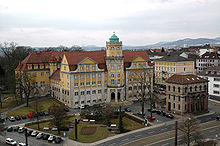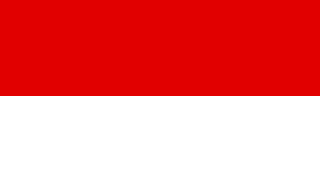
Hesse or Hessia, officially the State of Hessen, is a state in Germany. Its capital city is Wiesbaden, and the largest urban area is Frankfurt. Two other major historic cities are Darmstadt and Kassel. With an area of 21,114.73 square kilometers and a population of just over six million, it ranks seventh and fifth, respectively, among the sixteen German states. Frankfurt Rhine-Main, Germany's second-largest metropolitan area, is mainly located in Hesse.

Kassel is a city on the Fulda River in northern Hesse, Germany. It is the administrative seat of the Regierungsbezirk Kassel and the district of the same name and had 201,048 inhabitants in December 2020. The former capital of the state of Hesse-Kassel has many palaces and parks, including the Bergpark Wilhelmshöhe, which is a UNESCO World Heritage Site. Kassel is also known for the documenta exhibitions of contemporary art. Kassel has a public university with 25,000 students (2018) and a multicultural population.
Schaumburg is a district (Landkreis) of Lower Saxony, Germany. It is bounded by the districts of Nienburg, Hanover and Hamelin-Pyrmont, and the state of North Rhine-Westphalia.

This article is about the history of Hesse.
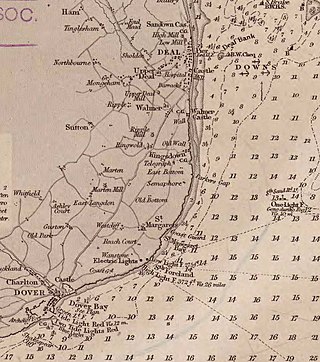
The Downs is a roadstead in the southern North Sea near the English Channel off the east Kent coast, between the North and the South Foreland in southern England. In 1639 the Battle of the Downs took place here, when the Dutch navy destroyed a Spanish fleet which had sought refuge in neutral English waters. From the Elizabethan era onwards, the presence of the Downs helped to make Deal one of the premier ports in England, and in the 19th century, it was equipped with its own telegraph and timeball tower to enable ships to set their marine chronometers.

Kassel is one of the three Regierungsbezirke of Hesse, Germany, located in the north of the state. It was created in 1866 when Prussia annexed the area to form the new province Hesse-Nassau. All together it consists of 138 municipalities.
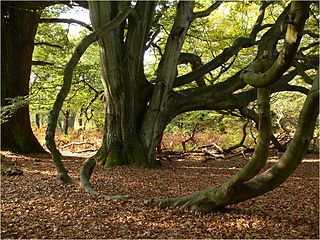
Kassel district is a district in the north of Hesse, Germany. Neighboring districts are Northeim, Göttingen, Werra-Meißner, Schwalm-Eder, Waldeck-Frankenberg, Höxter. The independent city of Kassel is nearly completely surrounded by the district.

The Landgraviate of Hesse-Kassel, spelled Hesse-Cassel during its entire existence, was a state in the Holy Roman Empire that was directly subject to the Emperor. The state was created in 1567 when the Landgraviate of Hesse was divided upon the death of Philip I, Landgrave of Hesse. His eldest son William IV inherited the northern half of the Landgraviate and the capital of Kassel. The other sons received the Landgraviate of Hesse-Marburg, the Landgraviate of Hesse-Rheinfels and the Landgraviate of Hesse-Darmstadt.
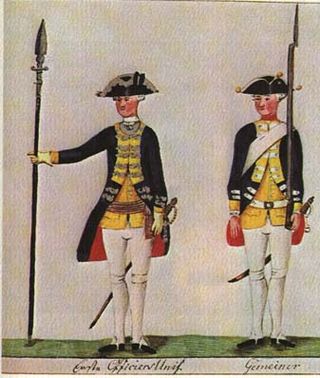
Hessians were German soldiers who served as auxiliaries to the British Army during the American Revolutionary War. The term is an American synecdoche for all Germans who fought on the British side, since 65% came from the German states of Hesse-Kassel and Hesse-Hanau. Known for their discipline and martial prowess, around 30,000 Germans fought for the British during the war, comprising a quarter of British land forces.

Frederick II was Landgrave of Hesse-Kassel from 1760 to 1785. He ruled as an enlightened despot, and raised money by renting soldiers to Great Britain to help fight the American Revolutionary War. He combined Enlightenment ideas with Christian values, cameralist plans for central control of the economy, and a militaristic approach toward international diplomacy.
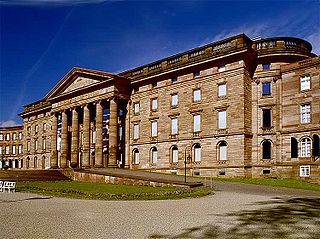
Schloss Wilhelmshöhe is a Neoclassical palace located in Bad Wilhelmshöhe, a part of Kassel, Germany. It was built for Landgrave Wilhelm (William) IX of Hesse in the late 18th century. Emperor Wilhelm II made extensive use of it as a summer residence and personal retreat.

The Universitätsbibliothek Kassel is a library located in the city of Kassel, Germany. Composed of the collections of the former Landesbibliothek and Murhardsche Bibliothek der Stadt Kassel as well as that of the Kassel University library, amongst the library's holdings is the manuscript of the 9th-century German poem, the Hildebrandslied.

The Landgraviate of Hesse was a principality of the Holy Roman Empire. It existed as a single entity from 1264 to 1567, when it was divided among the sons of Philip I, Landgrave of Hesse.
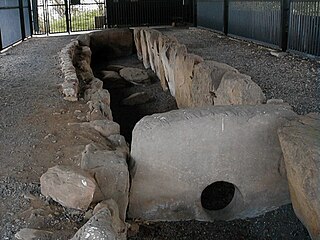
The Züschen tomb is a prehistoric burial monument, located between Lohne and Züschen, near Fritzlar, Hesse, Germany. Classified as a gallery grave or a Hessian-Westphalian stone cist, it is one of the most important megalithic monuments in Central Europe. Dating to the late 4th millennium BC, it belongs to the Late Neolithic Wartberg culture. The presence of incised carvings, comparable to prehistoric rock art elsewhere in Europe, is a striking feature of Wartberg culture tombs, known so far only from Züschen and from tomb I at Warburg.

Ethnic Germans served on both sides of the American Revolutionary War. Large numbers of Germans had emigrated to Pennsylvania, New York and other American colonies, and they were generally neutral or supported the Patriot cause. Some belonged to pacifist sects such as the Amish, but many were drawn into the Revolution and the war.

The Fridericianum is a museum in Kassel, Germany. Built in 1779, it is one of the oldest public museums in Europe. Since 1955 the quinquennial art festival documenta has been centred on the site, with some artworks displayed on Friedrichsplatz, in front of the building.

The Kassel tramway network is a 93.3-kilometer (58.0 mi) network of tramways, forming part of the public transport system in Kassel, a city in the north of the federal state of Hesse, Germany. As of 2014, the Kassel tram network is made up of seven regular tramlines.

The Neue Galerie is an art museum in Kassel in the state of Hesse, in Germany. The building was constructed between 1871 and 1877 as a museum for works of the Old Masters. The building was damaged and burned out on 22 October 1943 in a devastating air raid carried out on the orders of Winston Churchill. The 60 most important works were brought to Vienna, and were returned in 1956. The building and large parts of the collection were lost. The museum was reopened with its present name in 1976, and a large renovation was completed in 2011.
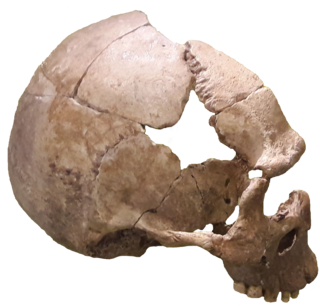
The Rhünda Skull is a fossil human skull that was found just outside the village of Rhünda in North Hesse, Germany. It is dated to the Magdalenian, about 12,000 years old.
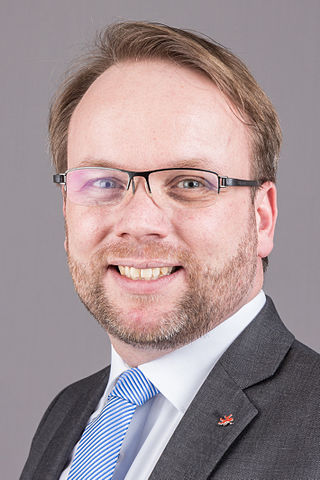
Timon Gremmels is a German politician in the Social Democratic Party (SPD) who has been serving as Member of the Bundestag for Kassel, in the German parliament, since 2017.
